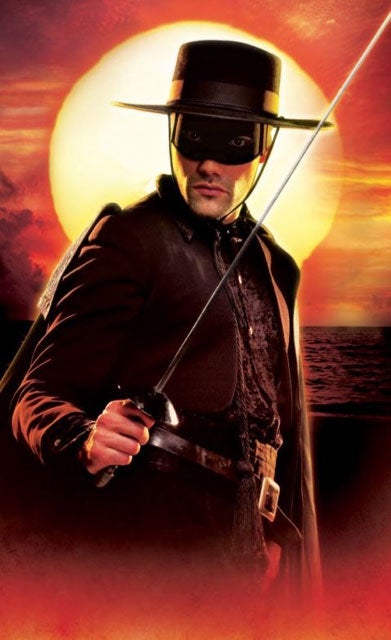Blade runner: Zorro on stage
As the original caped crusader swashbuckles his way on to the West End stage, Rhoda Koenig revisits the many guises of Zorro, from pulp fiction righter of wrongs to musical man of mystery

Eighty-nine years young, the original caped crusader will be reborn once more in the West End from today, as a singing, dancing, romancing, leaping, fencing, avenging, inexhaustible Zorro takes to the boards. With book and lyrics by Stephen Clark and music by the Gipsy Kings, Zorro!, starring Matthew Rawle, is the latest in a long line of moral masked men whose image has lately been retuned for the times.
The black-clad man of mystery saw the light in The Curse of Capistrano, a magazine serial by Johnston McCulley published in 1919. Set in 19th-century Spanish California, the story recounted the campaign of a liberal aristocrat against a cruel, corrupt governor. Don Diego Vega is a languid young man who "yawned ten score times a day" and tells his lady love he will send a servant to serenade her instead of coming himself, because he is afraid of catching cold.
Senorita Lolita Pulido naturally scorns this weed, but goes for the dashing Zorro, declaring, when he sees off a brute, "You saved me from the pollution of that man's lips. Señor, though you deem me unmaidenly, I offer you freely the kiss he would have taken!" Little does she know that the man whose voice, build, and bearing are disguised by a half-mask, the swordsman whose blade flashes "like the tongue of a serpent" as he carves his initial on his enemy's forehead, is the pusillanimous Don Diego!
McCulley did not invent the high-born hero who, pretending to be a weakling, is a daring freedom fighter. The credit for that goes to Baroness Orczy, who dreamed up Sir Percy Blakeney, alias the Scarlet Pimpernel. But his contribution of the mask and the cape and the setting of the American West created a vivid, appealing character who inspired two more. The Lone Ranger was the product of radio producers who wanted a Zorro-style figure; Bob Kane, taking the elements of wealthy wimp, secret cave, night, animal name ("zorro" is Spanish for "fox"), and mask, and turning the stallion, Tornado, into a car with mucho horsepower, came up with Batman.
The Spanish hero first made it on to the big screen in 1920's The Mark of Zorro, starring the greatest of Zorros, Douglas Fairbanks, whose gaiety and athleticism added traits to McCulley's character that have remained with it ever since. Fairbanks's Zorro was a laughing cavalier, as intent on ridiculing his enemies as punishing them.
Though nearing 40, Fairbanks was a splendid animal whose graceful feats of strength, accompanied by flashing ivories, make Burt Lancaster look, by comparison, morose and sedentary. In one scene Lolita sits on his raised left arm while he fends off several baddies with the blade in his right. Fairbanks could also perform the most delicate tricks with a heavy stock whip – he could snuff a candle, snap a cigarette from the villain's lips, and coil it around a dungeon's bars to make his escape.
The most memorable Zorro of the next generation was Tyrone Power, who in 1940 made a film with the same name as Fairbanks's, which has the most thrilling swordfight in pictures. The most famous manoeuvre, however, takes place before the fight begins: Rathbone challenges Power to cut a row of candles in half with his sword, Power swishes, they remain whole, Rathbone smirks, Power lifts the top half of one to show that he's slashed them so neatly they haven't moved.
Seventeen years on, Guy Williams became the first television Zorro. With domestic family viewing in mind, Zorro became less bloodthirsty, cutting his monogram into his victims' clothes rather than flesh. The dapper, quietly humorous Williams was as good a Zorro as the tacky production values of the series allowed, and was the best fencer of the lot.
The values of the Fifties may not have been that different from those of the Twenties and Forties, but, with The Mask of Zorro (1998), the story began to be pushed into more conformity with a world in which broken families and unmaidenly behaviour had become common – the scene in which Antonio Banderas enacts every swordsman's sex fantasy by using his blade to flick the clothes from Catherine Zeta-Jones helped make the movie a hit.
Zorro: A Novel of 2005 made many other changes. Isabel Allende wrote her book, the basis for the new musical (she is its producer), at the behest of the Zorro commercial interests and chucked in every fashionable cliché going – gypsies, pirates, a herbalist native grandmother who conducts an initiation rite... He travels to Spain, where he becomes a member of a secret society, formed to combat the Inquisition. Near the end of the book, he does get around to righting the wrongs of California, but the female narrator still regards him as tediously immature.
Rejigging a hero concocted to please a very different society is a tricky business, as some of the Zorro adaptors have found. For mass appeal, legends have got to be updated to appeal to audiences with different tastes and attitudes. The addition of rumba flamenca may be a jolly idea, and so may be a more spirited heroine. We shall see. Let's just hope that the new musical leaves out the wise woman and her herbs.
'Zorro!', previews at the Garrick Theatre, London WC2 (0844 412 4662; www.zorrothemusical.com), from today
Subscribe to Independent Premium to bookmark this article
Want to bookmark your favourite articles and stories to read or reference later? Start your Independent Premium subscription today.

Join our commenting forum
Join thought-provoking conversations, follow other Independent readers and see their replies